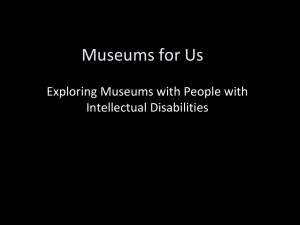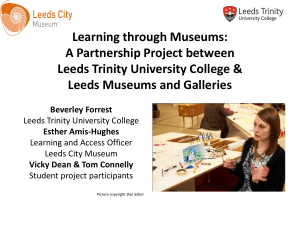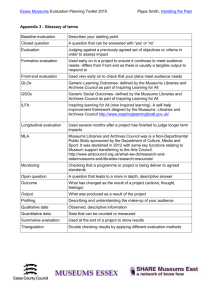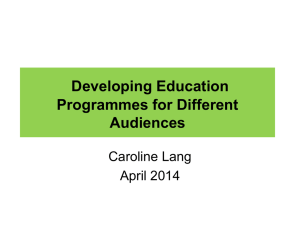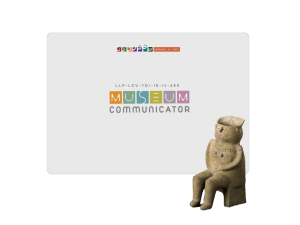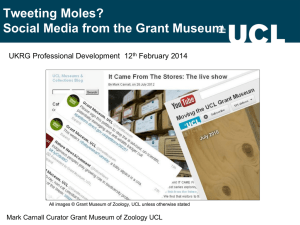Art Museums and the Internet
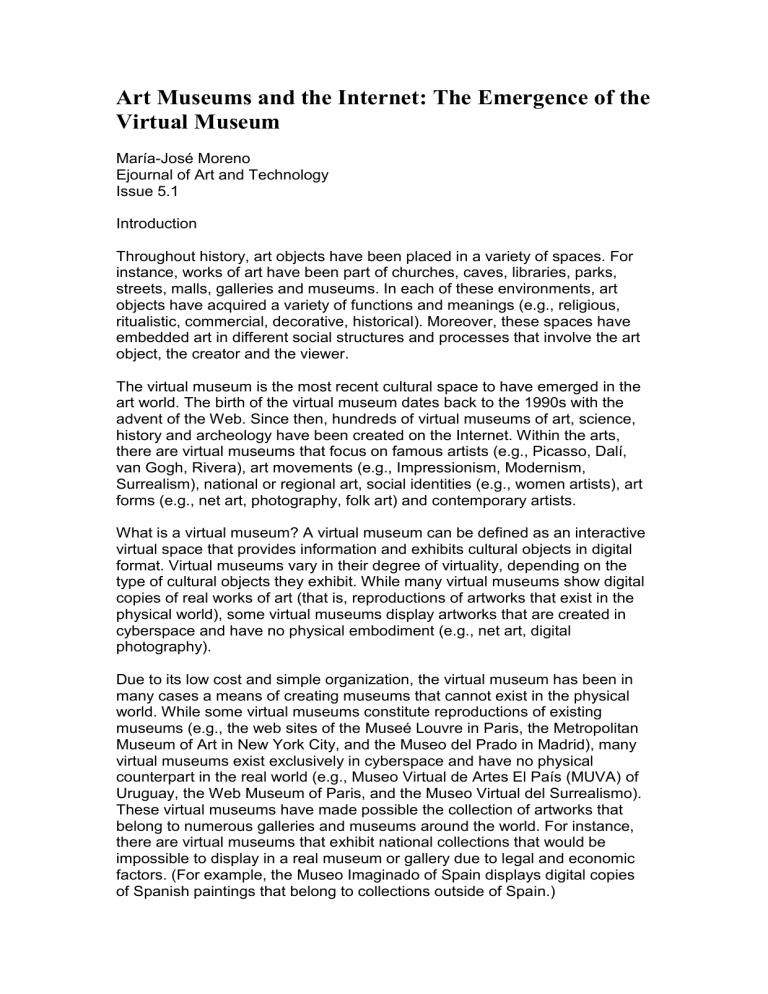
Art Museums and the Internet: The Emergence of the
Virtual Museum
María-José Moreno
Ejournal of Art and Technology
Issue 5.1
Introduction
Throughout history, art objects have been placed in a variety of spaces. For instance, works of art have been part of churches, caves, libraries, parks, streets, malls, galleries and museums. In each of these environments, art objects have acquired a variety of functions and meanings (e.g., religious, ritualistic, commercial, decorative, historical). Moreover, these spaces have embedded art in different social structures and processes that involve the art object, the creator and the viewer.
The virtual museum is the most recent cultural space to have emerged in the art world. The birth of the virtual museum dates back to the 1990s with the advent of the Web. Since then, hundreds of virtual museums of art, science, history and archeology have been created on the Internet. Within the arts, there are virtual museums that focus on famous artists (e.g., Picasso, Dalí, van Gogh, Rivera), art movements (e.g., Impressionism, Modernism,
Surrealism), national or regional art, social identities (e.g., women artists), art forms (e.g., net art, photography, folk art) and contemporary artists.
What is a virtual museum? A virtual museum can be defined as an interactive virtual space that provides information and exhibits cultural objects in digital format. Virtual museums vary in their degree of virtuality, depending on the type of cultural objects they exhibit. While many virtual museums show digital copies of real works of art (that is, reproductions of artworks that exist in the physical world), some virtual museums display artworks that are created in cyberspace and have no physical embodiment (e.g., net art, digital photography).
Due to its low cost and simple organization, the virtual museum has been in many cases a means of creating museums that cannot exist in the physical world. While some virtual museums constitute reproductions of existing museums (e.g., the web sites of the Museé Louvre in Paris, the Metropolitan
Museum of Art in New York City, and the Museo del Prado in Madrid), many virtual museums exist exclusively in cyberspace and have no physical counterpart in the real world (e.g., Museo Virtual de Artes El País (MUVA) of
Uruguay, the Web Museum of Paris, and the Museo Virtual del Surrealismo).
These virtual museums have made possible the collection of artworks that belong to numerous galleries and museums around the world. For instance, there are virtual museums that exhibit national collections that would be impossible to display in a real museum or gallery due to legal and economic factors. (For example, the Museo Imaginado of Spain displays digital copies of Spanish paintings that belong to collections outside of Spain.)
It is obvious that, due to their digital nature, virtual museums constitute a departure from real museums, which have been traditionally conceived as buildings that preserve and expose cultural objects. The purpose of this essay is to examine how the contents and social functions of the virtual museum differ from those of real museums. Although there exists an extensive literature on virtual museums, most studies focus on virtual museums that constitute web sites (reproductions or extensions) of real museums. I have found very few studies that analyze the case of entirely virtual museums of art, particularly the social dimensions of this phenomenon. In this paper I will therefore focus particularly on the case of virtual museums of art that exist exclusively in cyberspace, that is, on virtual museums that do not reproduce real museums. Moreover, I will discuss the impact the virtual museum has had in the structure and dynamics of the art world, that is, in the relations between the art object, the artist, the museum and the public.
The social function of the virtual museum
Art museums have been officially defined as institutions with a dual mission: the preservation and investigation of art works and the education of the general public. As the International Council of Museums (ICOM) specifies, an art museum is a ‘non-profit making, permanent institution in the service of society and of its development, and open to the public, which acquires, conserves, researches, communicates, and exhibits, for purposes of study, education, and enjoyment, material evidence of people and their environment’
[14].
Yet despite this dual social mission, art museums have traditionally focused on the preservation and study of collections that constitute the base and identity of these organizations and guarantee their prestige and legitimacy.
Museum administrators have generally considered the educational and public mission a complementary or secondary function to collection and preservation, despite the fact that during the last decades many museums have expanded their public mission as a response to professional standards and economic pressures [24; 26].
These official missions of the museum have also been tied to other social functions. As historical documents reveal, art museums have also had the function of defining social identities. Art museums have historically been instruments of social differentiation and institutions associated with the upper classes or with those social groups who possess cultural and economic capital [4; 5; 10]. Moreover, many museums have also been spaces dedicated to the construction and promotion of national identities [13]. For instance, according to historical accounts, the foundation of the first museums in Latin
America coincided with the independence and formation of the different Latin
American nations.
Placing the art museum in virtual space transforms to a large extent the basic functions of the museum. Similar to real museums, many virtual museums specialize in the construction and dissemination of national and regional identities. However, although virtual museums also constitute spaces of
historical documentation, it is obvious that in contrast to real museums, virtual museums do not have a preservation or conservation function in a physical sense due to their digital nature.
What then constitutes the basic social function of virtual museums? Because of their digital format, virtual museums have the primary function of providing visual and written information about art. They are fundamentally exhibition and public spaces. Although digital reproductions lack the physical presence of real objects, virtual technology provides a more effective and quick method of finding and processing information about art than real art museums and books. The virtual museum can display and make accessible a considerable number of artworks and information to a larger and more universal public than real museums. It is also accessible anytime from everywhere. In the case of virtual museums that display digital reproductions of real artworks, the visiting public can examine digital copies of masterpieces belonging to numerous collections, even those that are not accessible to the public in real museums due to their rarity or fragility. Furthermore, the multilayer format of virtual museums gives visitors the opportunity to choose the level of information that is most adequate to their level of expertise.
This dynamism and accessibility that characterizes virtual museums is accomplished through several digital formats and software tools. Virtual museums can be described as hypertexts and/or hyperspaces containing nodes, links and tools [12]. For instance, virtual museums that exhibit digital copies of real artworks may contain indexes (by artist, time period, style, nationality), search engines (to find particular artworks or a selected group of them), virtual tours (guided or free), dual window modes (through which the user can establish comparisons or associations between artworks in terms of style or subject), zoom options (through which the user can examine details of the images) and collaborative environments (where users can interact and chat). Museum web sites vary however in the type of format used to display the information or database. Two-dimensional virtual museums generally present digital images of artworks accompanied by information (the name of the artist, the title of the artwork, the date and the medium) in a linear and multilayer format. (Some well-known examples of this type of virtual museum are the Web Museum, the Web Gallery of Art, and the Museo Imaginado).
Three-dimensional virtual museums, on the other hand, simulate real museums by adding a sense of space to the virtual experience. (An excellent example of a three-dimensional virtual museum is the MUVA). In this type of museum site, the visitor navigates around the galleries and selects the collections he or she wants to contemplate. Two- and three-dimensional virtual museums therefore differ in terms of how the information presented is processed by the viewer. While in two-dimensional museums the user contemplates flat representations (similar to a book or photography), in threedimensional museums the viewer thinks in spatial, perspectival terms (similar to a museum visit). However, in both of these virtual environments, the viewer is able to access and process a larger amount of information more efficiently than is the case when visiting real museums.
To understand the public dimension and exhibition potential of placing art in a virtual environment, a comparison must be established with the case of photography. In his famous essay ‘The Work of Art in the Age of Mechanical
Reproductio n,’ Walter Benjamin shows how technological media that mechanically reproduce art objects, such as photography, expand ‘the exhibition value’ of art while reducing the ‘aura’ of the individual work [2, p.224]. According to Benjamin, the mechanical reproduction of art (through photography, for instance) eliminates the presence or aura of an art object and detaches the art object from its cultural context and ritual function so that
‘exhibition value begins to displace cult value’ [2, p.225]. Yet, at the same time reproduced art objects acquire new social functions and practices (e.g., political) as a result of their exhibition value.
As in the case of photographic reproduction, the digital reproduction of art in virtual space expands the exhibition value of art and reduces the aura of the artwork. Virtual technology eliminates the physical presence of artworks, but makes possible the exhibition of art to a larger public. In cyberspace, artworks can be placed in innumerable contexts (the personal space of the users) and acquire new social functions and practices depending on the users' location and interest. However, the exhibition value of digital reproductions extends beyond the boundaries of photography. Virtual technology differs from photography in its complexity and dynamism because it expands the number of options available to the viewer and reduces the amount of time required to gather information. A virtual museum visitor can have access to almost any work of art around the world (even to those works that are not accessible to the general public in real museums) and can instantly place the selected artwork in its historical context through various search options. The user can also, in some cases, contemplate any combination of artworks or different views of the same artwork (for instance, through the dual window mode or search indexes) and make instant comparisons between artworks and artists.
Moreover, virtual technology can recreate a sense of three-dimensional space that is lacking in the case of photography.
But the most significant characteristic of cyber technology that differentiates this medium from photography is its interactive nature. When art is digitally reproduced in cyberspace, it not only acquires an exhibition value, but also an interactive value. In the case of virtual museums that display digital copies of real artworks, the visiting public can navigate around any gallery and can, in certain cases, construct a personal gallery or collection from innumerable works of art (to a larger extent than photography does) through the various search options. Although virtual museums that digitally reproduce real artworks vary in their degree of interactivity, in some of these sites the virtual visitor can change the size and colors of a painting, rotate a sculpture, examine the details of the images (through the zoom option), or digitally restore, finish or construct a work of art that was never completed or realized.
These options constitute excellent tools for the study of art.
Furthermore, the interactivity that characterizes virtual museums of real artworks may not only involve the viewer and the artwork, but also museum visitors themselves. During recent years, administrators of virtual museums
have been trying to develop collaborative environments in cyberspace where users or participants can interact with each other and exchange views.
Although these software tools are beginning to be applied to virtual museums of art, it is a more common practice among virtual museums of science. Some examples of software tools that have been applied to virtual museums in order to create two- and three-dimensional cooperative environments are WebTalk-I and II, Net2Gether and Microsoft Virtual Worlds [1]. In these so-called collaborative environments, users are organized into chat groups (similar to museum tours) that may be coordinated by a leader or ‘tour guide.’ (A welldeveloped example is ‘Virtual Leonardo,’ developed by the Museum of
Science and Technology of Milan, where the software tool WebTalk-I was used to create a three-dimensional collaborative environment where users examine and discuss virtual representations of the machines designed by
Leonardo da Vinci.)
The interactive nature of virtual space is also evident in the case of virtual museums of net art (e.g., the Net Art Museum, the Museum of Web Art). Net art can be defined as dynamic, nonlinear and interactive visual systems in which images are constantly mutating and redefining themselves or are transformed or redefined by the viewer, who selects from the options provided by the artist. Works of net art are undefined and unfinished images that are shaped by an interactive creative process. The essence of net art does not emanate from its presence (as is the case of artworks that have material existence), but rather, is based on its interactive, ephemeral and changing nature. The aura of the artwork and the traditional notion of authenticity based on the physical presence of the original (as discussed by Walter Benjamin) is eliminated, since in net art the original (the coding system of the computer) is of no interest to the audience and all copies are identical. The case of net art can be compared to photography, where as Benjamin states, the original is the negative (also, of no interest to the audience) and the notion of the
‘authentic print makes no sense’ [2, p.224]. In the cases of net art and photography, ‘the work of art reproduced becomes the work of art designed for reproducibility’ [2, p.224].
As the above examples reveal, virtual technology expands the public dimension of traditional museums and the exhibition value of art objects because of its dynamic and interactive nature. But, how does placing an artwork in cyberspace transform the relation of the public to the work of art and to the museum? To what extent does the interactive nature of virtual museums change the role of the visiting public?
The virtual museum, the art object and the public
In his work Le Musée Imaginaire [18], Malraux discusses the ways in which the emergence of the traditional museum transformed the relationship between artworks and their context
– how the relocation of art objects from churches, public places and buildings to the museum separated the work of art from its cultural and historical meaning and underlined the style and identity of the creator. Portraits of historical figures became paintings. The portrait of the CountDuke of Olivares became a painting by Velázquez.
Similarly, we can argue that the virtual museum establishes a new relationship with respect to the work of art. In virtual museums, works of art acquire a complex set of meanings and functions because of the dynamic nature of cyberspace. Many virtual museums (of both digital reproductions of real artworks and net art) specify a location (a virtual gallery) for their art objects similar to real museums. The visiting public navigates through the galleries of the virtual building and selects the collections he or she wants to contemplate. However, in contrast to the real museum, the recontextualization of the art object in the virtual museum is multiple and transitory. The image of a work of art is ‘transported’ through the Internet to the personal space of the visitor, for example, to an office, a library, a room or a café, among other spaces. In each of these spaces, the digital copy of the artwork (which may be printed by the viewer for personal use) may acquire different meanings and functions. For instance, some works of net art can be installed in real environments, such as buildings, hotels, streets, parks and rooms, and can be used as additions to advertising and corporative environments or as complements of urban space [22]. The art object acquires a variety of meanings and purposes depending on the visitor's interest and physical context.
If the real museum distanced the work of art from its cultural context and attributed it to its creator, the virtual museum liberates the work of art from its academic or institutional context and its author and makes it accessible to the viewer, who in a certain sense re-creates and recontextualizes it. If the traditional museum transformed historical portraits into paintings, the virtual museum converts paintings into open and collective images. This view of art as a collaborative product (similar to the anonymity and collective nature of medieval works of art) is accentuated in the case of net art, where artworks are generally composed by a team effort that involves the artist (or artists), graphic and web designers and (in some cases) the viewer.
Digital technology therefore transforms the relation between the museum, the work of art and the visiting public. The interactive nature of the virtual museum permits the public to participate in the distribution and production of art to a certain extent. In the traditional museum, professionals such as curators, educators, art collectors and museum directors are in charge of the exhibitions and collections. However, in virtual museums that digitally reproduce real artworks, the visiting public may participate in the construction
(content definition) of the exhibitions and collections. For example, on the web site museumwithoutwalls.com (a virtual forum focused on the discussion of contemporary art), the audience is invited ‘to participate as guest curator’ and to give ideas for exhibitions of interest to the art public. Furthermore, on some web sites (such as The Web Gallery of Art) visitors can create their own exhibitions by selecting pictures from the entire collection of the museum
(through the search engine, the dual window mode and other features), or can can contribute to information files by submitting their web sites (as is the case of the Web Museum). The virtual visitor may also become a collector, as it is indicated in WonderWalker, a web site that consists of a collaborative virtual collection of objects constructed by the visiting public. (This site contains a
‘map space’ of icons that provide links to web pages chosen by the visiting
public, who are the collectors.) Wonder Walker proposes collecting as a social or public practice online that breaks with the concept of collecting as a private and elitist process. Moreover, some virtual museums (particularly those that display net art) may also invite the public to participate in the creative (artistic) process. For instance, in some virtual museums of net art, the viewer is given the opportunity to choose among multiple options (provided by the artist) when contemplating a work of net art. These options correspond to different dynamic images, so that the aesthetic visual experience is unique to each viewer.
Besides transforming the museum-audience relationship, the virtual context also presents a new scenario for the museum-artist relationship. If the inclusion of art objects in the exhibitions and collections of real museums has historically been the last step in the legitimation of art and in the recognition of an artist, the exposition of artworks in some virtual museums many times constitutes the first step in the promotion of new or unknown artists. Many virtual museums have become alternative spaces and avenues for the promotion of artists who do not have access to major real museums and galleries. For example, there are virtual museums and galleries that display work by contemporary artists (e.g., Artspan.com, Museo Virtual de Artes el
País) and women artists (e.g., WomenArt.com, 50 Women Artists of 50+). In these virtual museums and galleries, artists can distribute their work directly and independently (without the patronage of a complex network of art critics, dealers, curators, collectors and gallery owners) and can expose their work to an international audience and market (and become less dependent on their local or regional market). For instance, Artspan.com (a web site that contains the virtual museum museumwithoutwalls.com mentioned above), provides artists the opportunity to have their own web site and URL and become part of an online comunity of contemporary artists, artisans and photographers in return for a monthly fee. As the site indicates, Artspan provides the tools to manage the web site and sell the art, but it is the artist who is in control of the images and text of the web site. On this web site, artists can track visitors and
‘develop their own sales relationships with them’ without having to pay any commissions or additional fees, and visitors can contact artists directly ‘to inquire about or purchase their work.’ This new scenario (where artists control to a large extent the promotion of their work) has consequences for the bargaining power and economic position of artists, since in the traditional art market, dealers generally receive 40-70% of the gross sales price of artworks
[25].
Power structures and dynamics in the virtual museum world
The interactive and open nature of virtual museums brings forward the question as to what extent virtual technology can alter the structures of power in the museum world and produce a democratization of this sector. Some analysts have pointed out how the introduction of disruptive technologies generally brings about cultural democracy because these media make possible the massive distribution and accessibility of things that were originally limited to an elite or to those in power [3]. Some historical examples of disruptive technologies have been photography, music records and
television, each of which changed the existing relations and power structures in the art, music and movie industries respectively.
To a certain extent, it can be argued that the Internet provides a more democratic space in the museum world and enables the general population to have access to a domain that had been exclusive to a cultural and economic elite. In cyberspace, the public can have access to art collections and information that may not be so easily available in the real world, and can sometimes assume the role of art collector or curator. Artists, on the other hand, can distribute or promote their work without intermediaries or the patronage of art dealers, critics, gallery owners and museum professionals.
Yet the fact that the Internet is a resource still limited to an economic and cultural elite questions the extent to which digital technology can bring about a democratization of the museum sector and the art world. The Internet may democratize accessibility but it does not stand on equal availability. According to recent statistics on Internet usage, only 15% of the world population are
Internet users, even though Internet usage grew 167.1% between the years
2000 and 2005 [16]. When this data is divided by region, the statistics reveal that only 13.3 % of the population in Latin America, 2.7% of the population in
Africa and 9% of the population in Asia are Internet users, despite the fact that many Asian nations are among the top 20 countries with the highest Internet penetration rate [16]. Europe and North America constitute the regions with the highest percentage of Internet usage, with 35.2% and 68.2% respectively
[16]. However, although Internet usage is more widespread in North America, statistical studies of Internet usage in the United States reveal that overall,
Internet users there belong to the middle to upper classes [20] and have an average income of at least $50,000 and some college level education [21].
Although very few surveys of virtual museums indicate the income and educational levels of museum visitors, the available data (for both web sites of real museums and entirely virtual museums) shows that virtual visitors in the
United States tend to belong to the middle to upper social classes [15; 21].
For instance, in 1999, the average virtual visitor in the United States had an income of $53,520 and a higher degree [21]. Similar studies done in the
United Kingdom on particular virtual museums also corroborate the fact that virtual museum visitors tend to be more educated [7]. Moreover, other statistical studies on virtual museum visitors worldwide reveal that the social characteristics (e.g., age, gender) of virtual visitors are very similar to those of real museum visitors [6].
Like the real art world, the Internet appears to be a stratified space, a field of competition for the appropriation of cultural capital [4]. There are examples of virtual art galleries that have attempted to limit accessibility and to insert the elitism of the traditional art world into cyberspace. For instance, Hell.com, was a web site of net artists and galleries to which accessibility was limited to an exclusive list of members [8]. Another example is the portal Art.Teleportacia, a virtual gallery specialized in selling online access to net art.
On the other hand, there are online protest movements against cultural elitism that seem to echo or imitate the social and political activism of artists'
movements that have existed in the real world. Historical examples include the Art Workers Coalition; the New York Artists Strike Against Racism,
Sexism, Repression and War; Women Artists in Revolution; and the Guerrilla
Action Group, all of which were artists' movements that emerged in New York
City during the late 1960s and early 1970s to protest against the elitist policies of major museums and to demand an improvement of the socioeconomic condition of artists, particularly those belonging to minority groups [17]. One can find similar movements in cyberspace. An example is zero one dot org, a web site constructed by a group of Italian artists for the purpose of protesting against cultural and economic elitism [8]. According to its collaborators, zero one dot org duplicates art web sites (without copyright permission) in order to provide free access to virtual galleries not open to the general public on the grounds that information must be free and should not adhere to established structures based on economic capital.
As has been seen, the virtual art world is a complex and paradoxical space.
On the one hand, the emergence of virtual cultural spaces such as the virtual museum has brought about a reconceptualization of the museum, art (and authenticity), the artist and the public, as well as the relations that involve these elements, and has made possible an opening of alternative distribution avenues in the art world. On the other hand, the virtual world also seems to perpetuate or mirror the power structures of the real world. Internet usage is still limited to a minority of the world population and the profile of virtual visitors seems to mirror that of real museum visitors in terms of income and educational levels.
The question remains as to whether the virtual art world will eventually replace or change the established networks and standards, or whether it will become a complement of the real art world. I believe the second scenario seems more probable. There is no doubt that the Internet has had an impact in the distribution, consumption and production of art. As was discussed earlier, virtual museums and galleries have become alternative avenues and spaces for the promotion and study of art and have made possible the emergence of new distribution networks, art forms (e.g., net art) and processes involving the production of art. However, all of these developments seem to have become complementary scenarios to the established art world.
For instance, according to various reports, art enthusiasts and/or art buyers generally use virtual museums and galleries not as substitutes for real museums and galleries, but rather as information tools about specific artists and/or art movements that can be consulted before or after visiting a real gallery or museum [11; 23; 25]. Surveys on real museum web sites (that is, portals that digitally reproduce real museums) show that real museum visits are still above virtual museum visits [7]. Marketing reports also reveal that art sales on the Internet are still below those in the real art world, and have not matched the levels of consumer products such as books, electronics and toys sold on the Web [25]. Moreover, according to some critics, net art seems to have not been able to build a considerable and solid audience yet (and thus a community of potential collectors) within the art community and the general public [9; 19]. Some explanations given for the slow acceptance of net art have been the interactive, complex and dynamic nature of this new medium,
which requires an active encounter and some learning on the part of the viewer and the development of appropiate methods for presentation with low barriers to entry [19].
References
[1]
Barbieri, Thimoty and Paolo Paolini. ‘Co-operation Metaphors for Virtual
Museums.’ Archives and Museum Informatics: Museums and the Web 2001,
Seattle, Washington, USA, March 14-17, 2001. http://www.archimuse.com/mw2001/papers/barbieri/barbieri.html; accessed 1
August 2006.
[2]
Benjamin, Walter. ‘The Work of Art in the Age of Mechanical Reproduction.’
In Illuminations. Translated by Harry Zohn. Edited by Hannah Arendt. New
York: Schocken Books, 1969.
[3]
Betancourt, Michael. ‘Disruptive Technology: The Avant-Gardness of
AvantGarde Art.’ CTHEORY Article 107 (2002). http://www.ctheory.net/articles.aspx?id=336; accessed 1 August 2006.
[4]
Bourdieu, Pierre. Distinction: A Social Critique of the Judgement of Taste.
Translated by Richard Nice. London: Routledge & Kegan Paul, 1984.
[5]
Bourdieu, Pierre and Alain Darbel. The Love of Art: European Art
Museums and Their Public. New York: Plus Ultra Educational Publishers,
1978.
[6]
Bowen, Jonathan. ‘Time for Renovations: A Survey of Museum Web Sites.’
Archives and Museum Informatics: Museums and the Web 1999, New
Orleans, Louisiana, USA, March 11-14, 1999. http://www.archimuse.com/mw99/papers/bowen/bowen.html; accessed 1
August 2006.
[7]
Bowen, Jonathan, Jim Bennett and James Johnson. ‘Virtual Visits to
Virtual Museums.’ Archives and Museum Informatics: Museums and the Web
1998, Toronto, Canada, 22-25 April, 1998. http://www.archimuse.com/mw98/papers/bowen/bowen_paper.html; accessed
1 August 2006.
[8]
Diánez Pérez, Salvador. ‘La desacralización de las obras: exposición, distribución, copia y copyright.’ Netart. http://www.supercable.es/~sdianez/Netart.PDF; accessed 1 August 2006. 36-
48. Also available at: http://www.0100101110101101.org/texts/ceade_helltele-life-sp.html; accessed 1 August 2006.
[9]
Dietz, Steve. ‘Why have there been no great net artists?’ Web Walker Daily
28 (2000). http://www.walkerart.org/archive/5/B473851A45B7748A6161.htm; accessed 3 August 2006.
[10]
DiMaggio, Paul. ‘Cultural Entrepreneurship in Nineteenth-Century Boston.’
Media, Culture, and Society 4.1 (1982) 33-50; 4.4 (1982) 303-322.
[11]
Dixon, Pam. ‘Museums and the Wild Child that is Changing Everything: The
Web.’ N.p.: California Arts Council. Governor's Conference on the Arts, 1998.
Available at: http://www.pamdixon.com/webmuse.htm; accessed 3 August
2006.
[12]
Falquet, Gilles, Jacques Guyot and Luka Nerima. ‘Design and Analysis of
Virtual Museums.’ Archives and Museum Informatics: Museums and the Web
2001, Seattle, Washington, USA, March 14-17, 2001. http://www.archimuse.com/mw2001/papers/park/park.html; accessed 3
August 2006.
[13]
García Canclini, Néstor. Culturas híbridas: Estrategias para entrar y salir de la modernidad. México: Editorial Grijalbo, 1990.
[14]
General Assembly of ICOM. ICOM Statutes 16th General Assembly of
ICOM, The Hague, The Netherlands, 5 September 1989. http://icom.museum/statutes.html; accessed 15 August 2006.
[15]
Haley Goldman, Kate and Melissa Wadman. ‘There's Something
Happening Here, What It Is Ain't Exactly Clear.’ Archives and Museum
Informatics: Museums and the Web 2002, Boston, Massachusetts, USA, April
17 - 20, 2002. http://www.archimuse.com/mw2002/papers/haleyGoldman/haleygoldman.html
; accessed 3 August 2006.
[16]
Internet World Stats: Usage and Population Statistics. 2005. http://www.internetworldstats.com/stats.htm; accessed 3 August 2006.
[17]
Lippard, Lucy R. Get the Message? A Decade of Art for Social Change.
New York: E. P. Dutton, 1984.
[18]
Malraux, André. Museum without Walls (Le Musée Imaginaire). Translation by Stuart Gilbert and Francis Price. London: Secker & Warburg, 1967.
[19]
Morrisroe, Julia. ‘Wag, Wag, Wag.’ In Subverting the Market: Artwork on the Web. Mount Pleasant, MI: Central Michigan University, 2001.
[20]
Perry, M. ‘Demographics of Internet Users.’ Michigan State University,
2001.
[21]
Sarraf, Suzann e. ‘A Survey of Museums on the Web: Who Uses Museum
Websites?’ Curator 42.3 (1999): 231-243.
[22]
Stanza. Amorphoscapes. 2002. http://www.stanza.co.uk/dynamic/; accessed 15 July 2006.
[23]
Thomas, Wendy A. and Sheila Carey. ‘Actual/Virtual Visits: What are the
Links?.’ Archives and Museum Informatics: Museums and the Web 2005,
Vancouver, British Columbia, Canada, April 13-17, 2005. http://www.archimuse.com/mw2005/papers/thomas/thomas.html; accessed 3
August 2006.
[24]
Tonelli, Edith A. ‘The Art Museum.’ In The Museum: A Reference Guide.
Edited by Michael S. Shapiro. New York: Greenwood Press, 1990. 31-58.
[25]
Vickers, Marques. ‘Fine Art of Marketing Art, Chapter #1: The Internet
Evolves Commercially,’ The Quill in Focus. Pixiport Photography, 2003. http://www.pixiport.com/Gallery-W14-archives.htm; accessed 3 August 2006.
[26]
Zolberg, Vera L. ‘American Art Museums: Sanctuary or Free-For-All?’
Social Forces 63.2 (1984): 377-392.
About the Author
María-José Moreno has a PhD in Sociology from Columbia University and has conducted postdoctoral studies in the sociology of museums at the
Smithsonian Institution. She is currently an assistant professor of social sciences at the University of Puerto Rico. She has published in social science journals, primarily on the sociology and economics of art museums and on art and technology.


